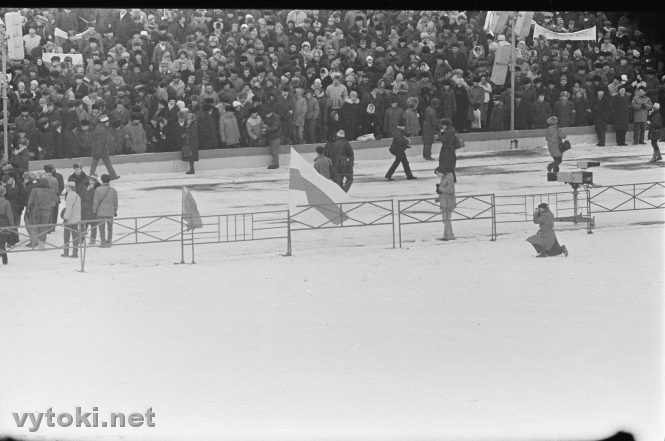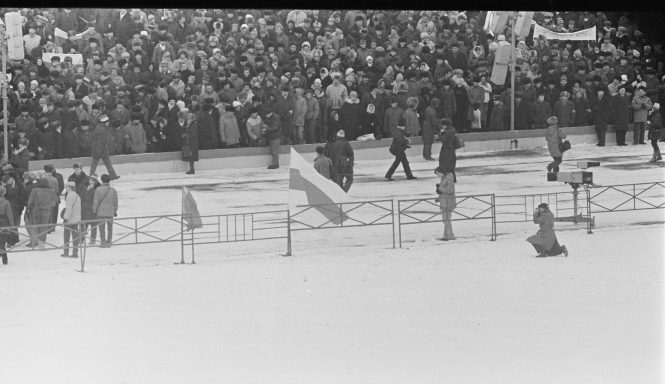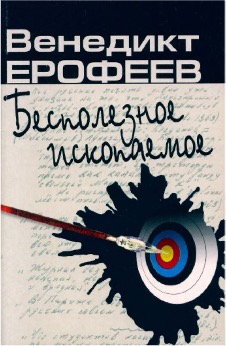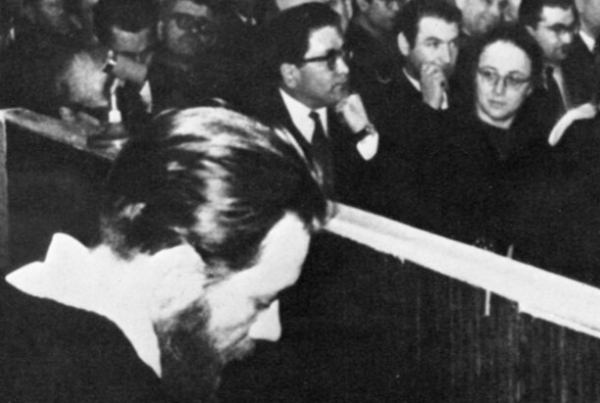Interview with Uladzimir Valodzin
edited by G. De Florio and F. Iocca
“We had non-conformism, but not the underground”: the intelligentsiia in Minsk between the 1950s and the 1980s

A meeting at Dynamo, 19.02.1989, Minsk. © photo by Vladimir Sapagov. Source: Vytoki.net
Is it possible to talk about unofficial Belarusian culture as a single phenomenon? Which groups, movements or events fit into this concept?
I can affirm that we had non-conformism, but not the underground, although it is very difficult to draw a ‘dividing line’ between the two concepts. In other words, there was an alternative way of thinking, but there was very little subsequent retreat into a parallel reality; there was no ‘second culture’. If we talk about decades, in general the thawing period was obviously more lively, although the thaw as it was understood in the provinces was very particular. On the other hand, the years of stagnation were years of great activity; on an artistic and creative level, stagnation was richer, because at a time when it was impossible to organise collective events, people stayed in their studios to create what would later ’emerge’ during perestroika. There were different groups, each with their own circle of knowledge; some communicated with each other, others did not. Avant-gardists and nationalists, for example, had practically no point of contact with each other.
There was also some people who had returned from labour camps; during the thaw years these people were important because they brought memories of avant-garde literature from the 1920s. They remembered the literary life of those times.
For the literary milieu and for some artists, Larisa Geniiush was an important point of reference. She lived in the provinces, in Zel’va, and was not allowed to live in the big cities. She was stateless (she was deprived of her Czechoslovakian citizenship but did not accept Soviet citizenship), she kept up a correspondence with Belarusian emigrants, with the Belarusian intelligentsiia in Vilnius. She was a representative of a national artistic and poetic culture, which is why poets, writers, artists, etc. came to visit her.
By the way, Vilnius was an extremely important city for the Belarusian intelligentsiia, including the non-conformists. I would even say more important than Moscow.
Is there any literature about the history of Belarusian non-conformism?
So far there is little work and research on this topic. There have been several attempts over the years. But we still do not have a narrative formulated on the basis of scientific research.
There was an attempt to offer a general overview in the History of Belarus (6 volumes), in which the subject is discussed in two chapters.
There are also two vade mecums on non-conformism written by Oleg Dernovich, published in 1999 and 2004, but these cannot be considered exhaustive.
There is a group working on the subject, with which I collaborate: they are open and ready to help anyone who is interested in the topic. The members of this group have created a wonderful website: Vytoki (Sources), https://vytoki.net, where samizdat documents, photographs, historical information, etc. are uploaded.
What was the relationship between these groups of writers/artists and the official Belarusian culture of the time? How did the official culture regard these culturally independent groups?
The authorities kept an eye on these groups, there was persecution, but to put someone in jail on the basis of political articles because of artistic works, as happened in Moscow and Leningrad, well this hardly ever happened in Belarus. Each case must be considered separately, there are many different situations.
Which were the most significant points of reference or aesthetic models in the evolution of the poetics of these groups? For example, did German Expressionism and Dadaism or the Russian avant-garde (especially Futurism, Zaum’ and OBERIU) play significant roles?
The majority of uncensored material circulating at that time had a political character. I am referring to samizdat of a political kind, for example The Situation in Belarus by Zenon Pozniak, or Letter to a Russian Friend by Aleksei Kavko. If we talk about aesthetic ideals, the nationalists were quite conservative. They were successful artists, they were members of the Union of Artists, they received orders, they had an optimal situation on a social level, but at the same time they reasoned, so to speak, about the ‘destiny of the fatherland’, they intervened in the preservation of historical monuments, etc. They were also conservative.
There were no intersections between these nationalists and the cosmopolitans like, for example, Khadeev’s group. There were isolated crossovers: someone moved from Khadeev’s tusovka (small group) to other more conservative circles. Khadeev, for example, was also very familiar with classical Belarusian culture and was involved in its interpretation. One cannot say that he was detached from Belarussian culture; he was simply distant from the nationalists; it is a different thing.
There were different types of nationalists. One can cite the examples of Zenon Pozniak and Aleksandr Riazanov. The former is a photographer and a fairly conservative art critic, the latter is a leading poet of modernism (or would it be better to say post-modernism?). Because his books were considered too innovative for the 1970s, they stayed with the publisher for 5 and 6 years. In the end, Riazanov was printed, even in the years of stagnation, he was a member of the Writers’ Union. Riazanov is the classic example of the intellectual who constantly assesses the soundness of the system and tries to promote his opinions through official channels, not taking an interest in samizdat, although he read it, not participating in the underground, although he may have had contacts with it. In other words, one foot here and one foot there. This was a common situation in Belarus. Some people intervened in favour of the preservation of monuments, of the Belarusian language, but at the same time their work was very often accepted by the authorities. In this respect, Riazanov is an exception, because he was a true avant-garde artist. As for the influence of Russian culture, that’s a good question, we should ask Riazanov what he read and when. He was certainly interested the Futurists, because Maiakovskii was accessible, but I don’t know if he was reading Kharms and the other members of OBĖRIU at the time.
I can also mention a story about two actors from the Russian theatre in Minsk who went on tour to Kazan’ in the late 1970s. There, in the university library, they found the works of the philosopher and thinker Nikolai Fedorov that had not ended up (or perhaps they had) in the special repository. They photographed them and transferred them in their entirety onto film, and on their return home printed them out for themselves. It was a ‘semisamizdat’, such a thing was not forbidden, and if they had been caught with those books they could not have been arrested. But inconveniences could not have been ruled out either. By the way, one of the two actors, Ėduard Goriachii, spent two years in a samizdat camp in the first half of the 1960s for spreading samizdat because of an episode that involved Kim Khadeev, and the production of Beckett’s Waiting for Godot, in which appeared with Valerii Shushkevich 1968 was semi-prohibited. It was a typical Belarusian situation, as if one were on the border, at the limits of what was allowed. There were also genuine political dissidents, such as Mikhail Kukobaka, who knew the Moscow dissidents. But that is another story.
Were there direct links between these Belarusian groups/movements and the contemporary Russian underground and unofficial Soviet culture?
Moscow was a city apart, with far more opportunities to meet and associate with foreigners. Minsk was more provincial. There were links with Moscow and Leningrad, but each exponent of artistic culture had their own contacts. It is very difficult to say who among the Moscow or Leningrad artists had a considerable influence on the artistic process in Belarus. It would also be interesting to investigate what happened in architecture in the 1960s and 1970s. Not least because Soviet architecture was oriented towards Western modernism; it is obvious that it cannot be called samizdat, considering that architects cannot work underground, can they? Therefore, the modernist aesthetic was very much present in architecture, and the authorities accepted it quite calmly.
An interesting thing happened: the avant-garde architects of Minks, supporters of modernism, wanted to demolish the old town in order to build their new experimental buildings, while the artists, who were conservatives from an aesthetic point of view, defended the old town as one of the foundations of national identity. In this case, who was the non-conformist? Quite a paradox.
Were there any non-conformist artists?
We had unofficial artists, but they only became groups in the second half of the 1980s. There were some in the 1960s, but they were individuals and did not gather in any circle or atelier. For example, Vitalii Chernobrysov had good contacts with unofficial artists in Leningrad, but in Minsk he was not particularly well-known. Some of the young artists of the 1960s were interested in Sutin; they tried to get information about him and visited to his parents in Smilavichi, where Sutin had spent his childhood. There were a few cases in those years, but the community of non-conformist artists was formed in the second half of the 1980s and in the 1990s. Some of the non-conformists of the 1970s did not participate in the official Unions (for example, Andrei Plesanov). There were also younger artists who had already finished school in the years of stagnation, but until perestroika they remained in their own milieu and did something, were involved in something, but only for themselves. And they only made themselves known in the years of perestroika. For example, Liudmila Rusova, Igor’ Kashkurevich.
Another example: Adam Globus (pseudonym of Vladimir Adamchik), a graduate of the Academy of Arts in painting, also came from a background close to the non-conformists, but he also had a second career. In the 1990s he became a businessman. In the early 1980s he organised semi-clandestine auctions of non-conformist art. The authorities came to know about it and asked him not to do it anymore, and the matter was closed.
Translation by Noemi Albanese
To cite this article:
Uladzimir Valodzin, Minsk intelligentsiia. Interview by G. De Florio and F. Iocca, in Voci libere in URSS. Letteratura, pensiero, arti indipendenti in Unione Sovietica e gli echi in Occidente (1953-1991), a cura di C. Pieralli, M. Sabbatini, Firenze University Press, Firenze 2021-, <vocilibereurss.fupress.net>.
eISBN 978-88-5518-463-2
© 2021 Author(s)
Content license: CC BY 4.0





